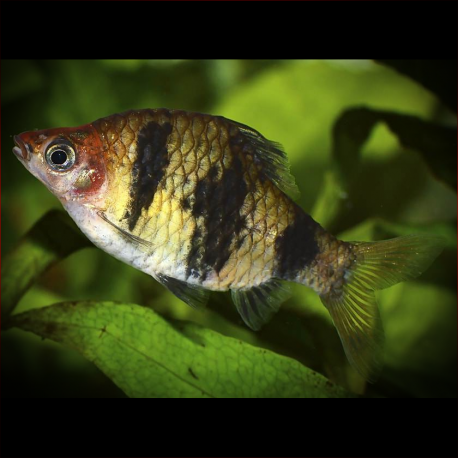More info
Datasheet
| Minimum Tank Size | 72 litres / 19.02 US gallons |
| Maximum Size | 5.5cm / 2.17inches |
| Temperature | 20°C / 68.00°F - 27°C / 80.60°F |
| Hardness | 2.02dgH / 36ppm - 15.02dgH / 268ppm |
| pH | 5.5-7.5 |
General Description
The Black Ruby Barb, scientifically known as Pethia Nigrofasciata, is a small peaceful fish commonly found in community aquariums. Also referred to as the 'purple-headed barb' or 'ruby barb,' this species was previously part of the Puntius conchonius group before being moved to the Pethia genus. It displays distinct coloration, with males being smaller, slimmer, and more vibrant, especially during the spawning period, where their bodies turn reddish-purple.
Aquarium Setup
When setting up an aquarium for the Black Ruby Barb, a tank size of at least 72 liters is recommended (see table). To enhance their coloration and behavior, a heavily planted tank with a dark substrate is ideal. Adding floating plants, driftwood, branches, and leaf litter can provide a natural environment for the fish. While filtration should not be overly strong, some water movement is appreciated, especially in a hill stream-type set-up.
Behaviour
Known for its peaceful nature, the Black Ruby Barb is a schooling fish that thrives when kept in groups of 6-10 individuals. Maintaining them in these numbers reduces skittish behavior and enhances the overall aesthetic of the aquarium. Male Black Ruby Barbs develop more vibrant colors in the presence of conspecific rivals.
Feeding and Diet
In the wild, Black Ruby Barbs are foragers, consuming a diet of diatoms, algae, small insects, worms, and crustaceans. In the aquarium, they readily accept small live and frozen foods like bloodworms, Daphnia, and Artemia, alongside high-quality dried flakes and granules. A varied diet is crucial, including foods with plant or algal content.
Reproduction & Dimorphism
Breeding Black Ruby Barbs is relatively straightforward, as they are egg-scattering free spawners with no parental care. Setting up a separate breeding tank with appropriate conditions, such as slightly acidic to neutral pH, is recommended. Adult males are smaller, slimmer, and more colorful than females, especially during spawning, where their coloration intensifies.
Habitat and Distribution
Endemic to Sri Lanka, the Black Ruby Barb inhabits the Kelani and Nilwala river basins in the southwestern 'wet zone.' Due to the prohibition of wild specimen exports, most available in the trade are bred commercially. Selective collection for the aquarium trade has led to concerns about impacting wild populations, exacerbated by habitat degradation and loss of forest cover in Sri Lanka. The species thrives in shallow, slightly shaded, and cool water habitats with low conductivity and sandy substrates, coexisting with various other freshwater species.
Etymology
The genus name, Pethia, derives from the Sinhala language, referring to small cyprinids. The species epithet, Nigrofasciata, stems from Latin, meaning 'black-banded,' a nod to its distinctive color pattern.

